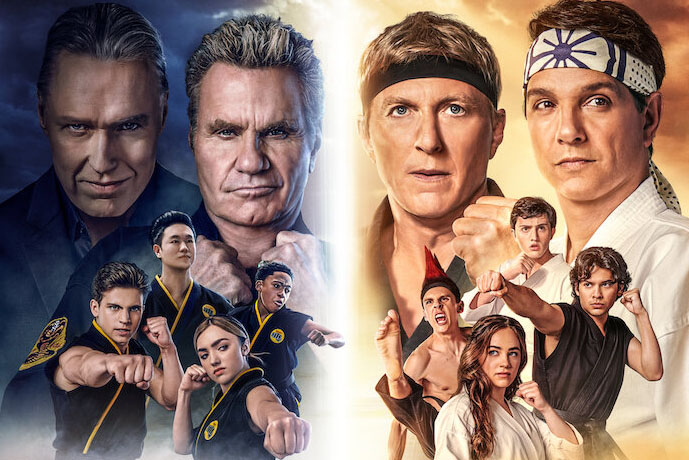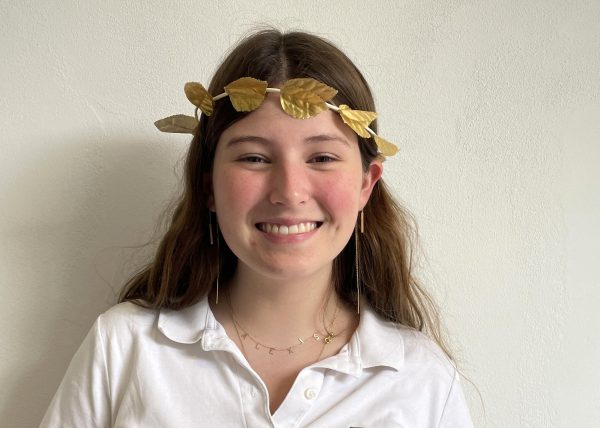Review: ‘Cobra Kai’ season four strikes hard
Photo credit: Cobra Kai Promotional Poster
This poster depicts the Cobra Kai team (left) and the combined Miyagi-Do and Eagle Fang team (right). The fourth season was announced on Dec. 2, 2021 with this promotional poster and was released on Dec. 31.
January 31, 2022
One day, while scrolling through Netflix, I came across their “Top 10” list. Up at number one, was “Cobra Kai.” After releasing the fourth season of the series, the show’s popularity has resurged, making it one of the most popular teenage shows at the moment.
Now, of course, I knew the basic premise of the show before I dove into this series. It’s a continuation of the iconic and well-loved 1984 “Karate Kid” film. I started the show assuming that it would be a fun and easy watch that I would occasionally put on as background noise while doing a homework assignment. But boy was I wrong. I binged all four seasons, 40 episodes, 20 hours worth of the series, in under two weeks. Each season just kept getting better, the characters kept growing and it all came to a head in the newest season.
For those who have yet to watch the show, I, firstly, beg you to do so (you won’t regret it), and secondly, offer you a spoiler warning. If you want a spoiler-free review, I recommend Rio Hundley’s 2020 review of the show. If you finished season three, however, and are trying to decide whether to continue watching, read on.
The fourth season starts off as frenemies and former rivals Johnny Lawrence (William Zabka) and Daniel LaRusso (Ralph Macchio), both returnees from the original “Karate Kid,” team up to win a bet against former senseis John Kreese (Martin Kove) and Terry Silver (Thomas Ian Griffith), also both from the original trilogy. At the end of season three, the four characters made a deal that whoever lost the All-Valley tournament would shut down their dojo for good.
Lawrence and LaRusso team up to have the best chance of beating their former senseis in the tournament but the team quickly falls apart. After LaRusso makes a comment about taking over Lawrence’s students’ training, hot-headed Lawrence takes his dojo, the Eagle Fangs, and leaves LaRusso’s dojo, Miyagi-Do.
The series also takes a close look at their students and their ever-changing relationships, friendships, rivalries and love for karate. Two of the main characters, Eli “Hawk” Moskowitz (Jacob Bertrand) and Miguel Diaz (Xolo Maridueña) especially steal the spotlight.
Hawk, a former victim of bullying, later turned bully, loses his mohawk, a physical manifestation of his confidence, and learns to embrace who he is in time to compete for the title of All-Valley champion. Hawk’s journey from a physically insecure kid to someone who learns to be confident in his own skin, despite the obstacles that stood in his way, powerfully resonates with all those who have had physical insecurities.
Diaz, my personal favorite, the “karate kid” and main character of the series, has to balance his desire to appease his sensei and father-figure, Lawrence, with his own inner struggles. Throughout the season, Diaz loses his passion for karate due to the mounting stress he faces, something many kids feel today when dealing with pressure from their parents.
In the eighth episode, entitled “Party Time,” Diaz and Lawrence share a heartwarming moment that is quickly ruined when a drunk Lawrence utters the name of his biological son, Robby Kenne (Tanner Buchanan), as he is saying “I love you.” Given Diaz’s insecurity regarding his relationship with Lawrence and the lack of connection he has with his biological father, this moment is a tipping point in their relationship.
The season all comes to a head in episodes nine and 10, appropriately titled “The Fall” and “The Rise.” The All-Valley tournament commences with our favorite and least favorite characters competing for the boys and girls All-Valley championship titles.
The ending of the season leaves us with many unanswered questions. All viewers can hope is that they’ll be answered in season five, which has already concluded filming.
Unlike past seasons, the audience experienced real growth from characters who had, before now, been pure villains. Nichols, a true embodiment of the Cobra Kai motto to “Strike First. Strike Hard. No Mercy,” is now shown to feel regret for playing dirty. Hawk, a character who had previously compensated for his insecurities, now learns to embrace them and find confidence in the face of them. And Diaz, a character who had so heavily relied on Lawrence, now begins to pave his own path and make his own decisions.
I did face some grievances with this season, however, specifically with Daniel LaRusso’s never-ending superiority complex and the sometimes slightly cringy, melodramatic dialogue that made the show seem more childish than in past seasons. Also, the number of new characters introduced and old characters who got more of the spotlight made it hard, at points, to keep up with all the plot lines.
All in all, this season was enjoyable. The old, tired storylines, relationships and rivalries were revamped, and characters who seemed set in their ways went through drastic mental and physical changes, making them much more well-rounded characters. And, the fight scenes were engaging, as always.
For those who have jumped on the “Cobra Kai” hate train, I kindly cite Johnny Lawrence: “I don’t know what that is but get off it, pronto.”
-
Binge Potential
-
Acting
-
Story
-
Technical Quality
Summary
“Cobra Kai” is not a cinematic masterpiece, not by any means, but it’s entertaining and has lovable characters. The storylines are never stale and viewers watch the characters go through extreme growth to find their true potential. The myriad of returning cast members makes this show a great callback to the original, and reignited my love for the classic 80s film.









